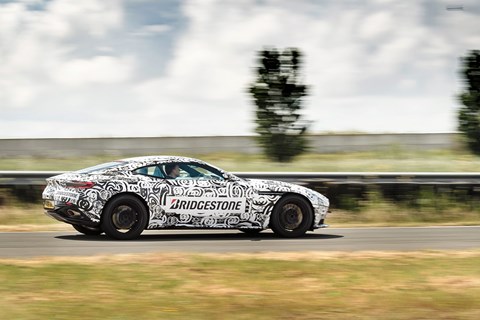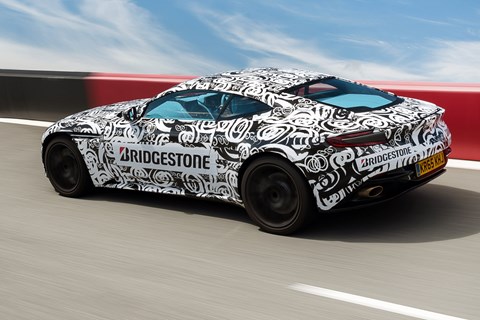► We drive a DB11 verification prototype
► Twin-turbo 5.2-litre V12, RWD, 8-spd auto
► On sale in late 2016 for £154,900
The first Aston Martin DB11 will be delivered in the final quarter of 2016, but it will not be an immaculate conception. New cars progress from rudimentary mules through to increasingly mature prototypes that are almost entirely representative of the finished article. They are often covered in hypnotic swirly wraps to attract spy photographers.
Occasionally, journalists are granted passenger rides in these cars; only rarely do they drive them. But Aston Martin has invited us to Bridgestone’s test track near Rome to do just that. The idea is we’ll get a first taste of Gaydon’s crucial new model, and provide feedback to chief engineer Matt Becker, he of Lotus chassis wizardry fame. Yes, we are under-qualified.
As replacement for the 2003 DB9, the £155k DB11 is critical for Aston Martin and represents a clean-sheet design. A bonded aluminium chassis is familiar, but the new platform is around 40kg lighter, some 20% stiffer and features a wheelbase increased by 65mm and front/rear tracks widened by 75mm/43mm respectively compared with DB9.
Marek Reichman’s gorgeous reinterpretation of DB design hides clever aerodynamic sculpting in the side strakes and C-pillars. And the DB9’s V12 is downsized from 5935cc to 5204cc to unlock a predicted 20% rise in efficiency, the cube deficit ably addressed by twin turbocharging. The engine remains an Aston Martin design produced by Ford in Cologne.
There’s new electrically assisted steering, a new multi-link rear axle (rear double wishbones are history) and the DB11 is larger than its predecessor, measuring 4739mm long, 1940mm wide and 1279mm tall (DB9 4689/1912/1282mm). Together with the V12’s additional turbocharging ancillaries, it explains why the kerbweight remains similar to the DB9’s, despite the lighter platform.
Today, we’re driving the dynamics team’s verification prototype. There’s a month of fine-tuning ahead, and refinements from other prototypes – those for powertrain and stability control, for instance – will be fed into the mix. When they are, TT (Tool Try-out) and PP (Pre-Production) prototypes will move towards a final fixed specification ahead of production. ‘The hardware is fully representative, but it’s the software tuning now,’ explains Becker. ‘This car is around 80-85% of the final production specification.’ It’s a long shot, but the things we say might actually make a difference.

The DB11’s butterfly doors open wide, welcoming you to sink down into incredibly low-slung seats with well-judged comfort and support. Close the door and you notice the extra space compared with the DB9, particularly the generous elbow room. Look behind and there’s no hiding this is still very much a 2+2 despite 87mm extra legroom; I’d have to be disassembled to spend a journey back there.
Ahead lies a new 12-inch TFT display with a central rev counter, a nicely proportioned multi-function wheel with two switches for the three damper and powertrain modes (GT, Sport, Sport Plus), and a long bonnet that stretches into the distance. It promises large displacement, easy torque and a noise like thunder through a Marshall stack.
Prod the central starter (no Indiana Jones insertion of jewel-like key into centre console this time) and it takes all of a few seconds to realise this new V12 is a corker. It revs freely and energetically, and marries regal grace with4 speed like a free-falling stone. The effortlessness of turbocharging is an ideal fit for a luxurious GT, yet it’s the way this motor retains a naturally aspirated character that really impresses: it responds crisply to throttle commands, suffers no real lag and sounds as eyebrow-raisingly rich as the Philharmonic’s brass and percussion sections letting off steam. No, 6500rpm isn’t particularly high, but then the old V12 offered only 250rpm more.
At 600bhp and 516lb ft it makes a useful if relatively modest 60bhp/59lb ft more than the DB9 GT, but the fact that all its torque floods in from just 1500rpm and hangs about until 5000rpm – 500rpm below the DB9’s torque peak – makes it feel far more urgent than its predecessor. And already it’s 32bhp/51lb ft clear of the old Vanquish – the most powerful naturally aspirated Aston V12 – for around a quarter less cash. Remember too, that there’s plenty more headroom with this engine than in those +2 seats.
Only the eight-speed ZF auto (arranged in a transaxle between the rear wheels) invites criticism. Changes are punchy enough in Sport Plus mode, but they lack the incisiveness not only of a Ferrari dual-clutch gearbox, but also Jaguar’s eight-speed auto, particularly the sometimes reluctant downshifts.
At high speed on track, the DB11 is deeply impressive. The fast 13:1 steering ratio makes the DB9’s feel distinctly leisurely, and this speed of response combines with relatively light weighting to impart a darty agility. The grip limits are very clearly telegraphed via grumbles from the front tyres, granularity through the rim and a tapering off in weight; you very quickly key in to its tactile messages.

The DB11 moves with a rigidity and assurance that belies its significant 1770kg without fluids, and traction from 20-inch Bridgestone Potenzas (the only OE fitment and size) is very good for such a powerful, torquey car, yet the DB11 retains a playful adjustability: add a stab of steering on corner-entry and the rear end will come into play, the power quickly giving you the means to exploit it.
Once he’s happy with the suspension tune, Becker’s team will layer on additional torque vectoring, which subtly grabs the brakes to help pull the nose into the apex. For now, that’s notable by its absence because the DB11 will settle into steady understeer through higher-speed turns. You also notice the weight of the V12 dropping over the outside front wheel, although that’s much less pronounced in the dampers’ Sport Plus setting.
Carbon-ceramic brakes will not be offered with the DB11 – they were standard fit on the DB9 – but the six-piston Brembos and grooved discs stand up well to repeated heavy stops. There’s a lack of definition at the top of the pedal, but Becker says they’re on it, that a new booster will fix it.
They’re also looking to improve the stability control calibration, which could be more seamlessly integrated than the sometimes abrupt intrusion we experienced. Becker understands, and bravely switches it all off from the passenger seat so I can slide around on the wet handling circuit. I repay his trust with a brief excursion onto the grass; no damage, but the DB11 looks like a zebra that’s been dragged through Mozambique by a lion when we return to base.
Perhaps leave that stability control as it is. In fact, let’s leave it all to Becker and his team. Because if this is how good the Aston Martin DB11 feels at 85%, I’d be astonished if it isn’t stupendously good when we drive the finished article in a few months.

The specs: Aston Martin DB11
Price: £154,900
Engine: 5204cc 48v twin-turbo V12, 600bhp @ 6500rpm, 516lb ft @ 1500-5000rpm
Transmission: Transmission 8-speed auto, rear-wheel drive
Performance: 3.9sec 0-62mph, 200mph, 24mpg (est), 270g/km CO2 (est)
Weight: 1770kg dry
On sale: Late 2016
Love – Responsive, characterful, powerful engine; agility
Hate – Understeer, sluggish downshifts, brake feel, ESC intervention
Verdict – Properly sporting GT needs fairy dust (which it’s getting)
Rating – ****
Up against
Better than: Bentley Continental GT – Aston’s more nimble, agile and fun
Worse than: Ferrari F12 – Much pricier, much more exciting
We’d buy: Ferrari F12 – Doesn’t look so bad with monthly payments
Read more from the June 2016 issue of CAR magazine